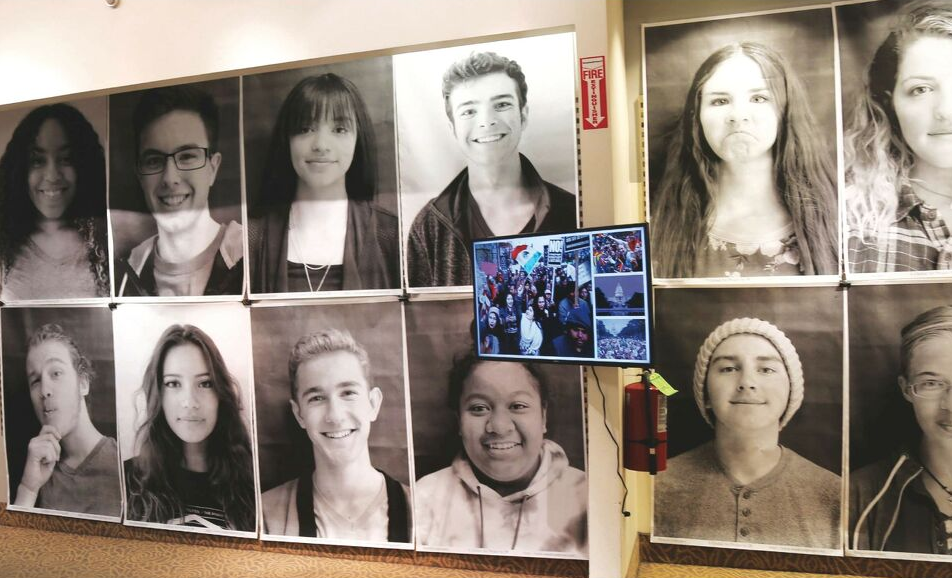
The Who Is American Today? digital storytelling exhibit at Artcetera Gallery in Provo, Utah.
As two visual arts educators, we are collaborating on a project that addresses many issues of national preoccupation that are reflected in the fragmented realities of today’s students. Our experiences, as a high- school educator in a district with a significant immigrant population and a higher-education researcher who is an immigrant herself, have shaped a project that seeks to articulate, share, and reflect upon the narratives and experiences of high-school students using digital storytelling in recognition of the unprecedented role that digital tools play in spaces of both learning and leisure for students today.
Digital Storytelling
Critical digital making strategies, such as digital storytelling, can be highly responsive and adaptable to the difficult realities and needs of students dealing with today’s world. These types of art projects can promote understanding and empathy. By creating and publishing original digital stories, students have the opportunity to experience how critical digital making can create possibilities for surpassing polarizing issues, engender shared understandings, and foster awareness of the relationship between critical digital making, citizenship, and the pursuit of a common good through democratic dialogue.
For this project, we used widely available, creative digital tools to help students articulate their voices as a means to promote dialogue and understanding of their perspectives. At the start of this project, it is important to emphasize to students they have the right to express their thoughts and opinions, and others also have the right to respectfully disagree. Creating a safe environment where all views are welcome is key to having students truly create and express their unique perspectives on timely issues.
Identity and Immigration
The topics of identity and immigration were something pressing upon students’ minds, in and out of my artroom. Historically, public schools have provided immigrants who arrive in the U.S. with a mechanism to integrate into mainstream American culture. Educators across the country uphold the notion that public schools are integral in sustaining America’s democracy, building on John Dewey’s ideas that education should prepare citizens to make informed, intelligent decisions leading to the public good.
Who Is American Today?
The prompt we decided to use with students for their video narrative was, “Who Is American Today?” The initial question sparked additional classroom conversations, which students were encouraged to continue with their peer groups and at home: “Think about this in terms of your family, school, and community. What ideas or people come to mind? What do these look like and what do they represent? Do you see yourself as an accurate representation of an American today?”
The topic was timely and we liked the overlap of a current issue with a popular technology. As teachers, we liked the idea of embracing the notion of students shifting from being pre-dominantly consumers of technology and becoming prosumers, making and contributing.
Today’s students have been raised with digital technology and tools, so we created a project that would leverage their communication abilities. In this participatory project, high-school students use digital storytelling to express their experiences in America. Students’ responses varied from the experience of not feeling recognized within their community to conveying a sense of connection and pride in being identified as “American” to views that were rooted in a society that is idealistically inclusive to all. Each student example demonstrates that students position themselves across a spectrum of perspectives on citizenship.
.png) Students combined photography with digital storytelling to express their experiences living in America
Students combined photography with digital storytelling to express their experiences living in America
Including Parents
Prior to students’ creative work in class, they were given a preliminary assignment: First, articulate your own views in writing, and then discuss this within your family. I have parents sign a release form since this project will be shared in physical and digital public spaces. It’s also a good idea to let parents know that you intend to address sensitive topics at the beginning of the semester by including a statement in the syllabus.
Progressive educators have an essential role in sustaining democracy and can explore difficult content within the safety of their classrooms. The arts provide students and teachers with opportunities to embrace the changes in society and to rethink teaching and learning as acts of consciousness that can raise and empower our students.
Flávia Bastos is professor of creativity and education at the School of Art, College of Design, Architecture, Art, and Planning, at the University of Cincinnati. BastosF@ucmail.uc.edu
James Rees is an art teacher at Provo High School, in Provo, Utah, and the NAEA Pacific Region vice president. James@JamesReesArt.com
NATIONAL STANDARD
Connecting: Relate artistic ideas and work with societal, cultural, and historical context to deepen understanding.
WEB LINK
NAEA Platforms and Supporting Position Statements
View this article in the digital edition.



.png) Students combined photography with digital storytelling to express their experiences living in America
Students combined photography with digital storytelling to express their experiences living in America